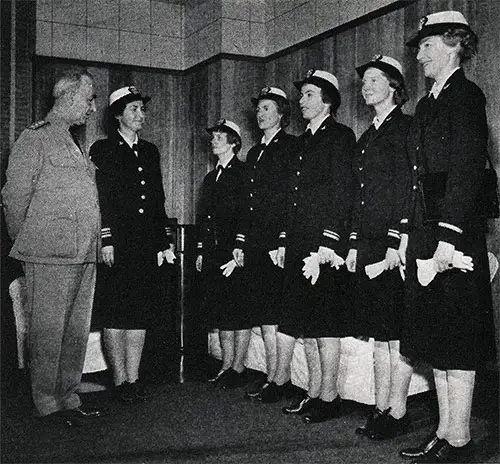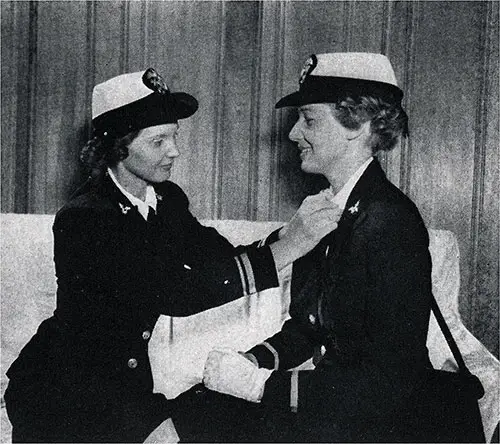The WAVES’ New Uniforms - A Historical Look at Women’s Service in WWII (1942)
📌 Explore the elegant and functional uniforms worn by the Women Accepted for Volunteer Emergency Service (WAVES) during WWII. Discover the significance of these uniforms in shaping women’s roles in the U.S. Navy, complete with detailed descriptions and photographs of key personnel.
The WAVES’ New Uniforms - October 1942
Relevance to the United States Navy for Teachers, Students, Genealogists, Historians, and Others
This article, The WAVES’ New Uniforms, provides a fascinating glimpse into the early 1940s military culture, showcasing the uniforms of the Women Accepted for Volunteer Emergency Service (WAVES).
The article is rich in historical and cultural significance, making it a valuable resource for historians and researchers studying women’s contributions to the U.S. Navy during World War II. It is also a key resource for educators in military history, social studies, or gender studies, offering an opportunity to examine the role of women in the military and how their integration was reflected in both clothing and societal perceptions.
For genealogists, this article offers valuable context for anyone researching female ancestors who may have served in the WAVES during World War II. It provides detailed descriptions of uniforms, rank insignia, and how women's military service was presented at the time, adding a layer of understanding for those tracing the experiences of their relatives in the U.S. Navy.

Rear Admiral Randall Jacobs, USN, Chief of the Bureau of Naval Personnel, inspects the new uniforms of the Women’s Reserve. Official Navy Photo. | GGA Image ID # 134b0da282
Who said Britannia rules the waves? Here are the ones who rule the WAVES of the US. Navy—RADM Randall Jacobs, USN, Chief of the Bureau of Naval Personnel, inspects the new uniforms of the Women’s Reserve, worn by (left to right) : LTCDR Mildred McAfee, director of the WAVES, and her staff, consisting of LT Elizabeth Reynard, LT Jean T. Palmer, LTJG Virginia Carlin, LTJG Marian Enright and ENS Dorothy Foster.

LTJG Enright adjusts the collar insignia of ENS Foster. Official Navy Photo. | GGA Image ID # 134b9aaa21
WAVES Uniforms
Officers' Uniforms
The regular uniform for officers in the Women’s Reserve of the U.S. Naval Reserve, which was designed by the noted designer Mainbocher, will be a shade of Navy blue. The jacket is simple in cut, with a rounded collar overlapping a pointed revere. It will have four gilt buttons, a straight back, two breast pocket flaps with a pocket on the left side under the flap and two inner pockets.
Skirt—6-gored, conventional sweep and length; two inset pockets at front.
Shirt—rayon with turned-down pointed collar and long sleeves with single-button cuffs. Piped yoke on front, centering in a deep V.
Raincoat (to serve also as topcoat and with inner lining as an overcoat)—double-breasted blue, water-repellent fabric and convertible collar. It is loose-fitting, raglan-sleeved, full skirted and full -belted. Overcoat is optional; blue, double- breasted, with double row of gilt buttons, shaped at the waist and held by a half-belt back.
Hat—oval with high, stiffened crown. Brim rolled at both sides but straight in front and back. Three detachable covers in blue, white and Reserve Blue. Naval officers’ insignia at front of crown attached to blue band.
Summer uniform—white, of similar design.
Work uniforms—Reserve Blue, similar style to other two uniforms. Worn only in hot months, it has a Reserve Blue shirt, same cut and design as winter shirt.
Tie—black, rayon, 11 inches wide and 33 inches long, with pointed ends. Shoes—plain laced oxfords, heel no higher than 1 1/2 inches; for evening wear, laced oxfords or simple pumps, heels not more than 2 inches high and toes closed. White laced oxfords or pumps with heels not more than 2 inches high with white uniform.
Hose—conventional length, medium-dark taupe, plain lisle, rayon or other similar material. Short, leather or fabric white or black gloves. Hand bag—to be worn from shoulder, of black fabric, not more than 11 inches wide or 8 1/2 inches high.
Rank—indicated by number and width of stripes on sleeves of jacket and overcoat; no shoulder boards. Rank to be shown with Reserve Blue on winter uniforms; Navy blue on working and summer uniforms.
Corps device of anchor imposed over propeller in white and Reserve Blue respectively for service blue uniform, on blue background; for working uniform propeller is blue and background Reserve Blue; white uniform, propeller blue, anchor Reserve Blue and background white.
Hat device is two crossed fouled anchors in gold with silver shield and spread eagle to face right. Buttons gilt, of standard U.S. Navy pattern.
Enlisted Uniforms
Generally speaking, same as for officers except enlisted uniforms will have black buttons and rating will take place of rank. Jackets and coats will be exactly the same in cut and style and the skirt will be exactly the same.
Hat will have a 6-section crown with wide, stitched brim. Navy blue for winter and summer hat with crown in white and brim in blue. Black band used by enlisted men with “U.S. Navy” in gold will be used.
Enlisted personnel will have only two shirts—one in Reserve Blue and one in blue of same design as officers’ shirt.
CPO uniforms will be same as others except that hat will be similar to regular officers’ hat. In place of officer’s device on hat, CP.O’s will wear fouled anchor in gold-colored metal with “U.S.N.” in silver superimposed.
Midshipmen’s Uniforms
Exactly same as for commissioned officers except for hat device, which will be a single fouled anchor of gold-colored metal or embroidered in gold-colored thread on a black fabric backing. Preliminary training uniforms same as for enlisted personnel except that midshipmen’s hat device will be worn with enlisted hat.
"The WAVES' New Uniforms," in Our Navy: The Standard Magazine of the United States Navy, Vol. XXXVII, No. 9, 1 October 1942, p. 37-38.
Key to Ranks
- RADM: Rear Admiral
- LTCDR: Lieutenant Commander
- LT: Lieutenant
- LTJG: Lieutenant, Junior Grade
- ENS: Ensign
- CPO: Chief Petty Officer
Key Highlights and Engaging Content
Uniform Design by Mainbocher
The new WAVES uniforms were designed by the renowned designer Mainbocher, whose style was famous for its elegance and simplicity. This is particularly engaging as it reflects the intersection of fashion and military service, highlighting how the Navy’s evolving inclusion of women in the workforce also intersected with societal trends in fashion. The design of the officers’ uniforms, with navy blue jackets and distinctive gold buttons, represented a blend of military formality and practical fashion, making it a stylish yet functional look for women in the service.
Detailed Descriptions of Officer and Enlisted Uniforms
The article provides comprehensive descriptions of both officer and enlisted personnel uniforms, emphasizing the differences in rank and function. Noteworthy details such as the gilt buttons on officers' jackets, the collar insignia adjustment by LTJG Marian Enright in a photo, and the more practical working uniforms provide readers with a rich visual and contextual understanding of the era’s uniforms. For educators, these specifics offer excellent material to discuss military uniform design and its symbolic significance.
Rank Insignia and Corps Devices
The explanation of rank insignia and corps devices, such as the anchor imposed over a propeller, provides insight into how the WAVES distinguished their personnel. This would be particularly interesting for military history enthusiasts as it reveals how the Navy developed a visual code to represent female officers and enlisted personnel, reinforcing their roles and responsibilities within the service.
Photographs of Key Personnel
The photographs of Rear Admiral Randall Jacobs inspecting the new WAVES uniforms and LTJG Enright adjusting the insignia are notable for their historical value and visual appeal. These images not only capture the formal atmosphere but also provide a personal touch, bringing to life the women who were pioneering in military roles during a time when women’s participation in the armed forces was still a relatively new concept.
Enlisted and Midshipmen Uniforms
The detailed section on enlisted personnel uniforms and midshipmen’s uniforms further enriches the content. It contrasts the slightly more formal officers' uniforms with those of enlisted personnel, while providing information about the midshipmen's devices on their hats, emphasizing the diverse roles that women took within the Navy.
Educational and Historical Insights
📌 The WAVES' Role in WWII: The WAVES played a critical role during World War II, allowing women to serve in various non-combat roles, such as clerks, typists, and radio operators, among others. The uniforms were not just functional but also symbolized female empowerment within a traditionally male-dominated military.
📌 Uniforms as a Reflection of Changing Gender Roles: The uniforms serve as a reflection of changing societal norms during the 1940s, with the Navy officially integrating women into the workforce. The designs convey a message of military professionalism while also acknowledging the changing views on gender equality within the military.
📌 Material and Design Choices: The use of blue fabrics and the incorporation of elements like the double-breasted raincoats and gilt buttons are reflective of both the military tradition and the unique requirements of female personnel during wartime. Understanding these choices adds depth to the study of military uniform design and the practical needs of women in service.
Final Thoughts
The WAVES’ New Uniforms - October 1942 is an essential resource for those studying the integration of women into the U.S. Navy during WWII. This article offers visual documentation of the uniforms, giving readers insight into the military, social, and cultural context of the time.
It is a key document for historians and educators, offering a detailed account of how military service for women was not only a social milestone but also a symbol of national pride.
For genealogists, the inclusion of precise uniform descriptions and rank insignia provides crucial context for researching female ancestors who served in the WAVES.
The article’s combination of fashion, history, and military tradition makes it a rich resource for anyone interested in the U.S. Navy’s development during this transformative period.
